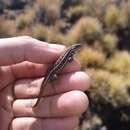en
names in breadcrumbs


Sceloporus bicanthalis, the trans volcanic bunchgrass lizard, is a species of lizard in the family Phrynosomatidae, first described by Hobart Muir Smith as a subspecies of Sceloporus aeneus in 1937.[2] It is endemic to Mexico.[1][2] It was classified by the IUCN as a species with low risk.[1] No subspecies are recognized.[2]
Sceloporus bicanthalis is a small, viviparous lizard measuring on average 45 mm (1.8 in) in snout–vent length.[2]
Sceloporus bicanthalis ranges eastwards from the eastern Valley of Mexico to the eastern end the Trans-Mexican Volcanic Belt, and into the northern Sierra Madre de Oaxaca.[1]
This species is associated with tussock (bunchgrass) grassland habitats within open pine forests at elevations of 2,900–4,400 m (9,500–14,400 ft) asl.[1]
Sceloporus bicanthalis, the trans volcanic bunchgrass lizard, is a species of lizard in the family Phrynosomatidae, first described by Hobart Muir Smith as a subspecies of Sceloporus aeneus in 1937. It is endemic to Mexico. It was classified by the IUCN as a species with low risk. No subspecies are recognized.